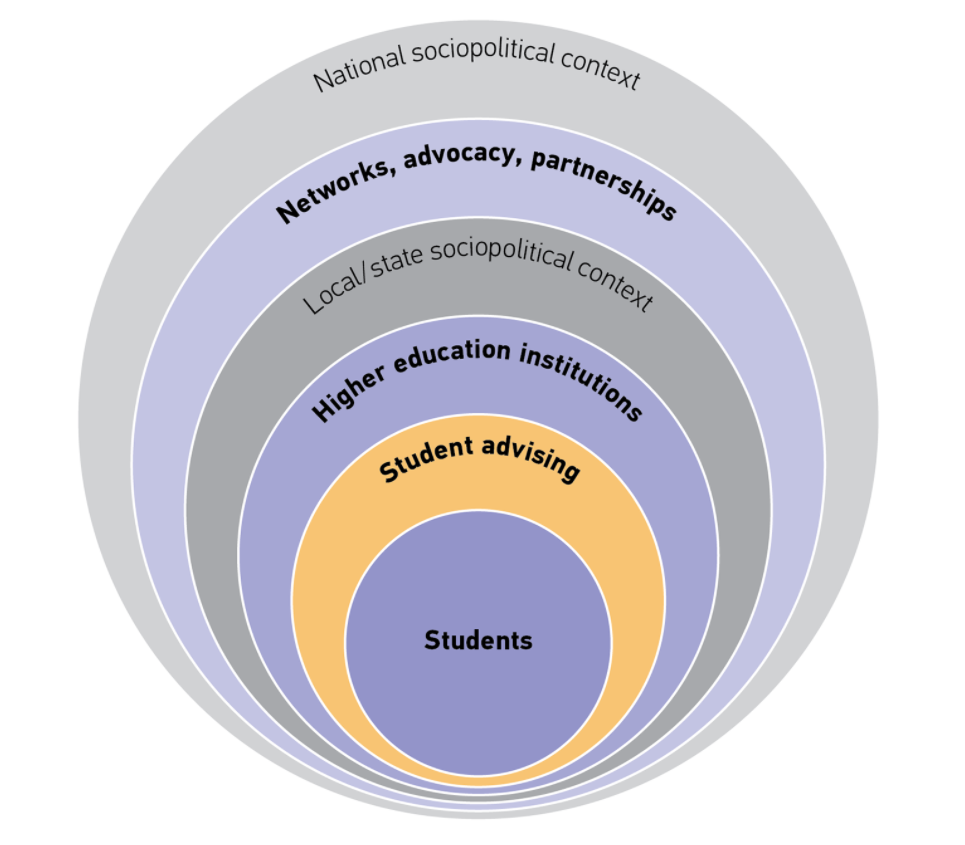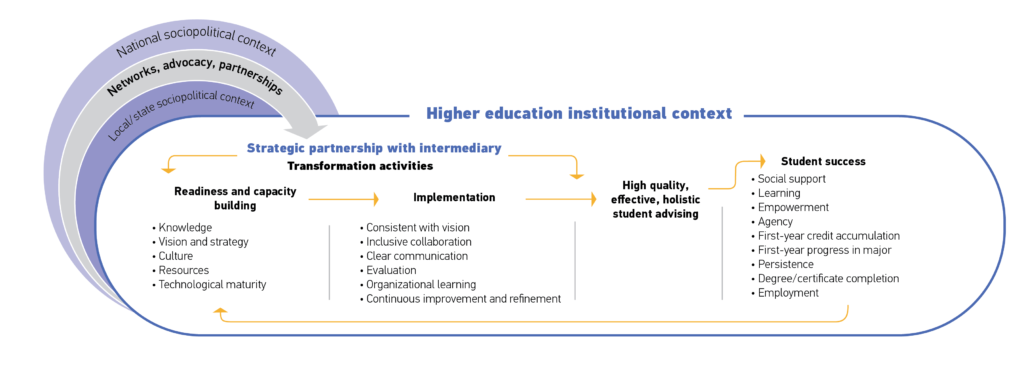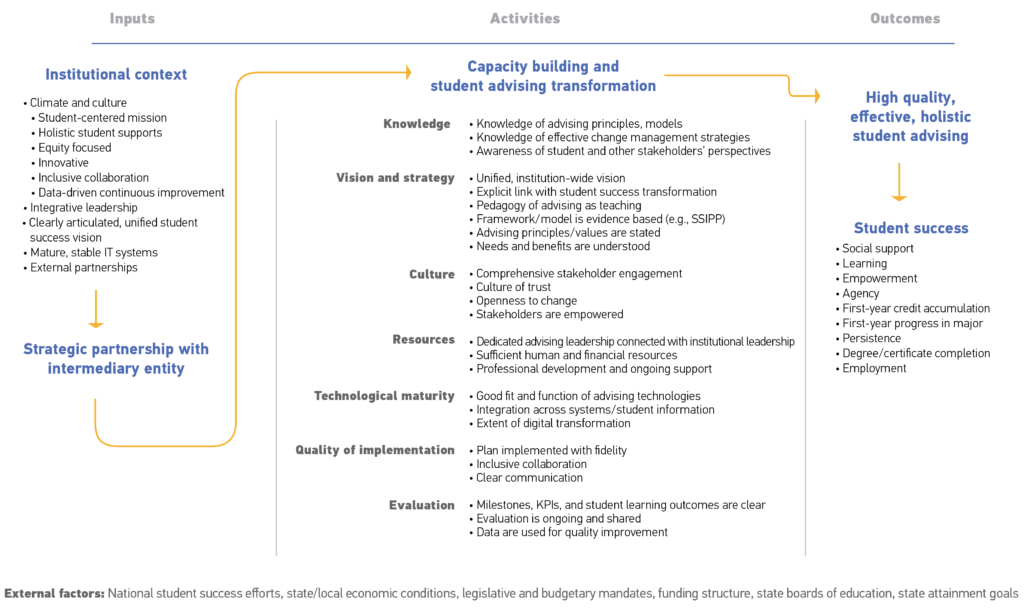Is there a yellow brick road—a single best path—guiding the effective use of technology to promote student advising transformation? If not, can we identify multiple roads that can lead an institution to improved and equitable outcomes?
Finding the path is tricky. Student advising transformation is complex and heavily influenced by context. Given the relative youth of advising transformation, our goal with this research is to identify and articulate lessons learned from institutions engaged in technology-mediated advising redesign, in order to suggest promising practices that support higher education through this process. Our research is guided by the belief that we are most likely to identify these lessons learned when we engage all stakeholders, use multiple research methods, and synthesize findings across studies and contexts.[1]
Theoretical Foundations
Ecological systems theory provides an overarching framework to examine the design, planning, and implementation of technology-mediated student advising.[2] It highlights the importance of both personal and environmental influences, as well as the dynamic, reciprocal, and transactional influences between contexts (i.e., ecology) and systems (e.g., intrapersonal, interpersonal, family, community). Other theories that inform this work (e.g. social support, organizational development, interorganizational relations, network, and connectivism theories) also address the complex interplay of factors that influence student advising redesign.

Figure 1. Ecological model of student advising
Identifying Lessons Learned and Promising Practices
Successful Redesign in Context – a Theory of Change
Our theory of change for successful technology-enabled advising redesign hinges on a multi-layered understanding of the various contextual influences within which stakeholders involved in redesign operate.
- Advising transformation is situated within an institution yet external contexts (e.g., local, state, and national sociopolitical contexts) influence redesign.
- Institutional readiness and capacity building facilitate successful advising transformation.
- An institution’s strategic partnership with an external intermediary organization that provides technical assistance, expertise, and other resources may serve as an important lever of change.
- Effective transformation leads to high-quality, effective, holistic student advising, which ultimately leads to improved student outcomes.
- The transformation process as ongoing, iterative, and additive.

Figure 2. Theory of advising transformation
Putting theory to action: Which institutional contextual inputs and transformational processes support successful student advising transformation?
The logic model (figure 3) expands on the theory of change by providing more detail about what factors and actions may be most important in the transformation process. On the left of the model under inputs, key aspects of the institutional context that enable successful transformation include:
- supportive culture;
- integrative leadership;
- mature and stable IT systems;
- and a clear unified student success vision.
The model also suggests that a strategic partnership with an external intermediary may enhance transformation readiness and capacity building, which in turn support successful transformation. In the center of the model, under activities, capacity building aims to strengthen stakeholders’ knowledge, vision and strategy, culture, resources, and technological maturity. Further, the quality of implementation and ongoing evaluation reinforce transformation success. Finally, successful transformation strengthens high-quality, effective, holistic student advising, which leads to student success.

Figure 3. Advising transformation logic model
Conclusion
Experience and theory suggest that advising transformation is complex, and it is unlikely that there is one yellow brick road leading to effective advising transformation. Instead, there are likely multiple paths to effective student advising redesign. The key is identifying promising practices in the transformation process that enhance realization of effective redesign and understanding how these may differ across institutional contexts.
We offer the models presented here as a way to facilitate successful advising redesign. Their value comes from articulating what elements may be essential to ensuring that transformation leads to positive student and institutional outcomes. While grounded in theory and existing evidence, the relationships depicted in the models are assertions. Further research is needed to test the presence of these relationships and uncover which, if any, are more important to realizing positive outcomes, growth, and equity for all students. Moreover, we see the models as works in progress to be further developed with input from the field and informed over time by additional research.
This blog is excerpted from Effective Use of Technologies in Student Advising: Is There a Yellow Brick Road?, published in EDUCAUSE Review on April 13, 2021 and can be accessed here.
Carol Nixon is Principal Consultant at Evaluation Design and Senior Research Fellow with EDUCAUSE, where she is engaged in research that articulates promising practices in the use of student advising technologies that ultimately support institutions’ holistic student advising initiatives.
—-
[1] Urie Bronfenbrenner, The Ecology of Human Development: Experiments by Nature and Design (Cambridge, MA: Harvard University Press, 1979).
[2] Michael Quinn Patton, “Evaluation, Knowledge Management, Best Practices, and High Quality Lessons Learned,” American Journal of Evaluation 22, no. 3 (September 1, 2001): 329–336.
